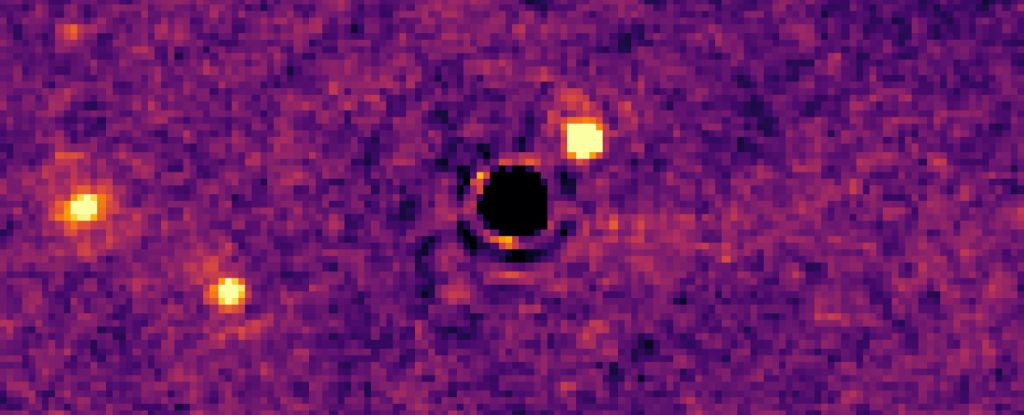
Smallest Alien World Ever Seen Spotted by JWST in Stunning First
How did your country report this? Share your view in the comments.
Diverging Reports Breakdown
Smallest Alien World Ever Seen Spotted by JWST in Stunning First
JWST has discovered its first exoplanet, around 111 light-years away. TWA-7b is a cold gas giant with about a third of the mass of Jupiter. It orbits its red dwarf host star at a staggering distance – 52 times farther than Earth orbits the Sun. The discovery demonstrates the promise of JWST, not just for studying exoplanets indirectly, but for finding and studying them directly, beyond the range other instruments can reach, say the researchers in a paper published in the journal Astronomy and Astrophysics. The world is about the same mass as Saturn, according to their analysis of the data. It’s the smallest world that humanity has ever directly imaged, but it could have a mass as light as 25 to 30 Earth masses if it was present, the researchers say. They believe that JW ST is capable of observing worlds that are less massive than TWA 7b, based on the way starlight passes on the TWA. They say the discovery is an exciting prospect for further study of planets.
Around a newly formed star just 111 light-years away, the powerful space telescope has officially discovered its first exoplanet. It’s called TWA-7b, and it’s the smallest world that humanity has ever directly imaged.
TWA-7b is a cold gas giant with about a third of the mass of Jupiter, orbiting its red dwarf host star at a staggering distance – 52 times farther than Earth orbits the Sun. In our Solar System, that distance would place TWA-7b out in the Kuiper Belt, far beyond the orbit of Pluto.
Related: Stunning Direct Images of Alien Worlds Are Detailed Enough to Reveal Clouds
The planet isn’t the only remarkable thing here. So detailed are the observations that a team led by astronomer Anne-Marie Lagrange of the Paris Observatory in France has been able to confirm predictions about how planets form, and their interactions with their environment.
The discovery, the researchers say, demonstrates the promise of JWST, not just for studying exoplanets indirectly, but for finding and studying them directly, beyond the range other instruments can reach.
“The present results show that the JWST Mid-Infrared Instrument (MIRI) has opened up a new window in the study of sub-Jupiter-mass planets using direct imaging,” they write in their paper.
“Indeed, TWA-7b (about 100 times the mass of Earth) is at least 10 times lighter than the exoplanets directly imaged so far, and planets as light as 25 to 30 Earth masses could have been detected if present.”
To date, nearly 6,000 exoplanets have been confirmed, out there in the Milky Way galaxy. That’s pretty exciting, considering how hard they are to discern. They’re very small, very dim, and very far away; the vast majority of them have only ever been measured indirectly, based on changes their presence wreaks on the light of their stars.
We’ve only actually directly seen around 80 exoplanets.
frameborder=”0″ allow=”accelerometer; autoplay; clipboard-write; encrypted-media; gyroscope; picture-in-picture; web-share” referrerpolicy=”strict-origin-when-cross-origin” allowfullscreen>
The star TWA-7 is perfectly positioned in space for attempting to directly image an exoplanet. It’s around 6.4 million years old, which is the star equivalent of a toddler – so young that it’s still surrounded by a leftover disk of the material that fed the baby star as it grew.
It’s from these disks that planets are born. Material clumps together as it orbits the star, gradually building up until there’s enough mass to constitute a world. This process creates gaps in the disk where the new planet carves out a space and creates rings, ‘shepherding’ the material on either side of the gap, a lot like the shepherd moons of the rings of Saturn.
Well, so we think. As Lagrange and her colleagues note, “no planet responsible for these features has been detected yet.”
TWA-7 is oriented in such a way that its pole is pointing at Earth. That means that astronomers can see the full disk of material around it, divided into three distinct rings. Lagrange and her colleagues pointed JWST at this disk, looking to see if they could identify an exoplanet in one of the gaps between the rings, creating a cavity for itself in the material around TWA-7.
“We unambiguously detected a source 1.5 arcseconds from the star, which is best interpreted as a cold, sub-Jupiter-mass planet,” they write. Their analysis suggests that this world is about the same mass as Saturn.
It’s a marvelous discovery, one that dramatically extends the lower mass range for directly detectable exoplanets. It’s also possibly only scratching the surface; the researchers believe that JWST is capable of observing worlds that are much less massive than TWA-7b.
The telescope is often used to analyze exoplanet atmospheres based on the way starlight changes when it passes through. Direct imaging is an entirely different way of studying exoplanets that can reveal details that are difficult to obtain in any other way.
frameborder=”0″ allow=”accelerometer; autoplay; clipboard-write; encrypted-media; gyroscope; picture-in-picture; web-share” referrerpolicy=”strict-origin-when-cross-origin” allowfullscreen>
The researchers conclude that TWA-7b is an exciting prospect for further study.
“TWA-7b is very well suited for further detailed dynamical modelling of disk-planet interactions,” they observe.
“As it is angularly well resolved from the star, TWA-7b is suited for direct spectroscopic investigations, providing the opportunity to study the interior and the atmosphere of a non-irradiated sub-Jupiter-mass, cold (about 320 K) exoplanet, and start comparative studies with our much older and cooler Solar System giants.”
The research has been published in Nature.
Source: https://www.sciencealert.com/smallest-alien-world-ever-seen-spotted-by-jwst-in-stunning-first
